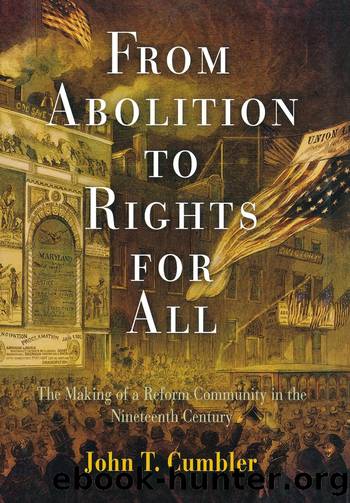From Abolition to Rights for All by Cumbler John T.;

Author:Cumbler, John T.;
Language: eng
Format: epub
Publisher: University of Pennsylvania Press
Chapter 8
âPublic Society Owes Perfect Protectionâ: The State and the Peopleâs Rights
Justice to All! Let Us Stand on That.
âJulia Ward Howe
Utter Truth and Labor for Right.
âWendell Phillips
Fifty years after the organizing of the American Anti-Slavery Society, the old comrades came together in Philadelphia to commemorate the event. It was a moment partly to celebrate that slavery had been abolished, partly to reinforce commitment to racial equality in face of repeated attacks, and partly to remember fallen comrades: Garrison had died the year before. Wendell Phillips could not make the gathering, but he sent a letter that was read before the group. In it he proclaimed that the struggle against slavery was a struggle for social justice, and that it did not end until justice reined on earth. âLet it not be said,â Phillips reminded those gathered, âthat the old abolitionist stopped with the Negro, and was never able to see that the same principles he had advocated at such cost claimed his utmost effort to protect all labor, white and black, and to further the discussion of every claim of down-trodden humanity. Let it be seen that our experience made us not merely abolitionists, but philanthropists.â1
Phillips saw philanthropy not as moral uplift or Christian charity, but as action to redress the wrongs of inequality. âLabor . . . claim[s] our aid in the name of that same humanity and justice which originally stirred us. We always proclaimed that it was not only the protection of the Negro we aim at, but that we sought to establish a principle, the right of human nature. In that view it seems to me we are narrow and wanting if we do not contribute the energy and skill which so many years have aroused and created to those questions which flow so naturally out of ours and belong to the same great brotherhood.â2 Although Octavia Hill and Samuel Barnett demonstrate that his view was not universally held, Phillips was not alone in seeing philanthropy and charity not as social control or noblesse oblige but rather as action for social justice and natural rights. Franklin Sanborn proclaimed, âPhilanthropic enterprises . . . had for their object the amelioration of the woes or redress of the wrongs of humanity.â3
This large vision of philanthropy was shared by many of those who had come through the abolitionist struggle, including Massachusetts governor John Andrew. By the time of the Civil War many of these abolitionists who for so many years had been shunned and held outside of the circles of influence were now at the center of power. The political abolitionist group known as the Bird Club had created a political machine that by the 1860s dominated Massachusetts state power.
In 1863 Governor John Andrew, active abolitionist and radical Republican, pushed the state legislature to create a âState Board of Charitiesâ to look at the issue of poverty and need in the state. Andrew reached deep inside the abolitionist community for many of his appointments to the board, which included
Download
This site does not store any files on its server. We only index and link to content provided by other sites. Please contact the content providers to delete copyright contents if any and email us, we'll remove relevant links or contents immediately.
| Africa | Americas |
| Arctic & Antarctica | Asia |
| Australia & Oceania | Europe |
| Middle East | Russia |
| United States | World |
| Ancient Civilizations | Military |
| Historical Study & Educational Resources |
Cat's cradle by Kurt Vonnegut(15189)
Pimp by Iceberg Slim(14398)
4 3 2 1: A Novel by Paul Auster(12289)
Underground: A Human History of the Worlds Beneath Our Feet by Will Hunt(12027)
The Radium Girls by Kate Moore(11930)
Wiseguy by Nicholas Pileggi(5674)
Perfect Rhythm by Jae(5326)
American History Stories, Volume III (Yesterday's Classics) by Pratt Mara L(5257)
The Fire Next Time by James Baldwin(5251)
Paper Towns by Green John(5092)
Pale Blue Dot by Carl Sagan(4915)
A Higher Loyalty: Truth, Lies, and Leadership by James Comey(4851)
The Mayflower and the Pilgrims' New World by Nathaniel Philbrick(4428)
The Doomsday Machine by Daniel Ellsberg(4420)
Killers of the Flower Moon: The Osage Murders and the Birth of the FBI by David Grann(4387)
The Sympathizer by Viet Thanh Nguyen(4307)
Too Much and Not the Mood by Durga Chew-Bose(4278)
The Borden Murders by Sarah Miller(4251)
Sticky Fingers by Joe Hagan(4105)
